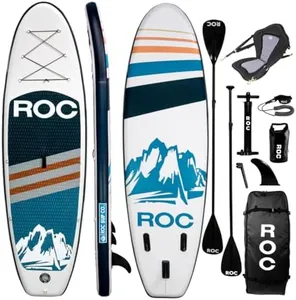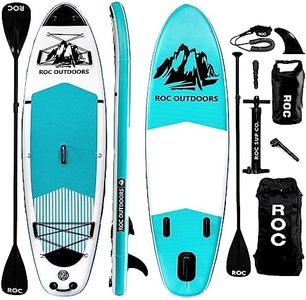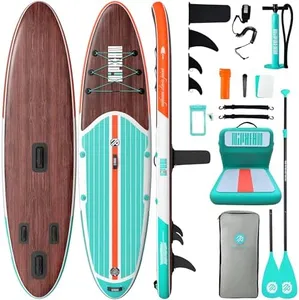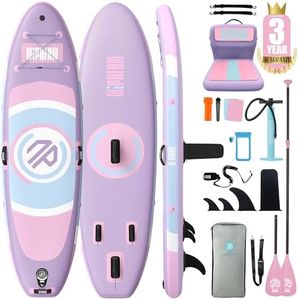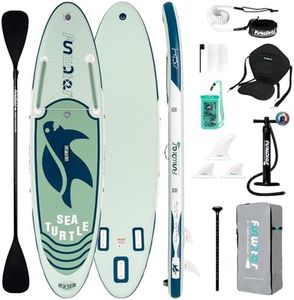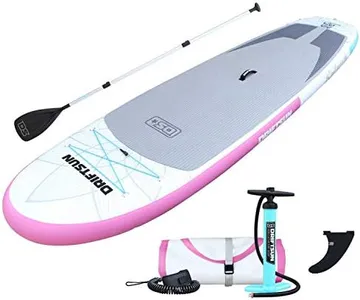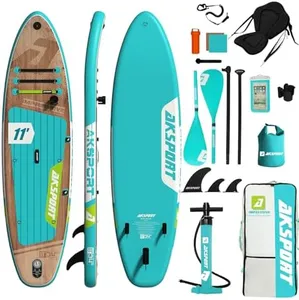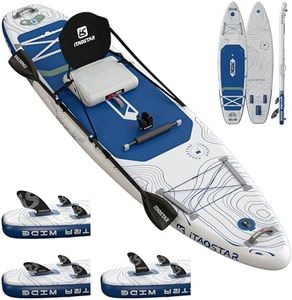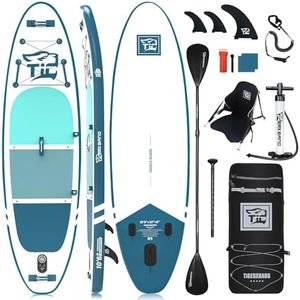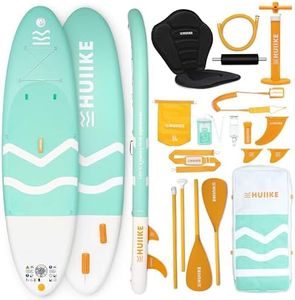10 Best Inflatable Paddle Boards With Seats 2025 in the United States
Our technology thoroughly searches through the online shopping world, reviewing hundreds of sites. We then process and analyze this information, updating in real-time to bring you the latest top-rated products. This way, you always get the best and most current options available.

Our Top Picks
Winner
Roc Inflatable Stand Up Paddle Boards with Premium SUP Paddle Board Accessories, Wide Stable Design, Non-Slip Comfort Deck for Youth & Adults (Navy W/Kayak Seat)
Most important from
18077 reviews
The Roc Inflatable Stand Up Paddle Board is a solid choice for anyone looking for a versatile and stable paddle board with a seat option. Its size is generous at 120 inches long and 33 inches wide, providing an extra-wide surface that helps with balance and makes it suitable for beginners and more experienced users alike. The board boasts a high weight capacity of 350 pounds, allowing it to comfortably accommodate most adults along with some gear. Made from high-grade PVC material that is 50% stronger than many competitors, this board is built for durability and reliability, which is important for long-term use and safety.
The included kayak seat attachment increases comfort and makes the board more versatile for different paddling styles. The wide design suggests good tracking and stability in the water. Being inflatable and lightweight at 18 pounds, it should be manageable for most users to handle at the start and end of their sessions. The package comes with premium accessories that add value for buyers who want an all-in-one setup. While marketed for youth and adults starting from age 12 (with supervision), smaller children may need an appropriate fit.
The 3-year warranty and strong customer rating of 4.8 out of 5 demonstrate confidence in the product's quality and company support. This paddle board is well suited for casual to intermediate paddlers wanting a stable, durable, and feature-rich inflatable board with a comfortable seat included.
Most important from
18077 reviews
Roc Inflatable Stand Up Paddle Boards with Premium SUP Paddle Board Accessories, Wide Stable Design, Non-Slip Comfort Deck for Youth & Adults (Teal)
Most important from
18077 reviews
The Roc Inflatable Stand Up Paddle Board is a strong choice for both beginners and experienced paddlers looking for a stable and reliable board with a seat option. Its extra-wide design (33 inches wide and 126 inches long) enhances balance, making it easier to paddle whether you’re standing or sitting. Made with high-quality PVC material claimed to be 50% stronger than many competitors, it promises good durability for regular use. The board can support up to 350 pounds, which is higher than many other models, making it suitable for heavier users or carrying extra gear.
A standout feature is the included kayak seat, allowing you to comfortably switch between sitting and standing. This flexibility supports longer outings or those who prefer a more relaxed ride. The board comes as a full pack with premium accessories including a paddle and pump, providing everything needed to start right away.
At 18 pounds, the board is moderately heavy compared to some ultralight models, which might be a consideration if you need to carry it long distances. While the board is durable, PVC boards can be vulnerable to punctures if not handled carefully. This paddle board is suitable for adults seeking a versatile, sturdy board with a seat for comfort and stability, making it a good fit for casual paddlers, families, or anyone who values ease of use and premium accessories in one package.
Most important from
18077 reviews
Niphean Paddle Board with Seat, 10’6’’ Paddleboard Inflatable Paddle Board with Seat Anti-Slip EVA Deck and StabilTrac Fin, Inflatable Paddle Boards for Adults & Youth of All Skill Levels
Most important from
2759 reviews
The Niphean 10’6” inflatable paddle board with seat is a solid choice for adults and youth at all skill levels who want a versatile and reliable board. Its size (10’6" x 33") is well balanced, providing good stability and maneuverability on various water types, including lakes, rivers, and even light ocean conditions. It supports a hefty weight capacity of up to 450 lbs, making it suitable for larger users or carrying extra gear. The board is made from durable PVC material with a 6-inch thickness, which offers rigidity and toughness, helping it handle impacts and rough use.
The included inflatable seat adds comfort for longer paddling or fishing trips, and the 11 D-rings increase versatility by allowing attachment of the seat or other accessories like coolers. The fin setup is practical, with one StabilTrac fin for straight tracking and two additional detachable fins to enhance stability and control. Inflation and deflation are straightforward with the supplied pump.
Accessories are generous: you get an adjustable paddle, safety leash, backpack for easy transport, waterproof phone bag, and a repair kit, which means you’re ready to go right out of the box. The anti-slip EVA deck improves comfort and foot grip, which is crucial for safety on the water. Some drawbacks include the board’s weight at 19 lbs, which is a bit heavier than some competitors, potentially making it less ideal for very frequent solo transport. The Niphean inflatable paddle board with seat delivers a well-rounded package with quality construction, useful accessories, and flexibility for different activities like yoga, fishing, or casual paddling, making it a dependable option for those seeking a versatile and stable board that balances comfort and performance.
